Companies seeking to gain market share have to execute an organization strategy that allows them to differentiate and win in the marketplace. There are many ways for organizations to differentiate. These may include, but are not limited to:
- Great customer service
- Most innovate product offerings
- Most convenient delivery method
- Best or most convenient location
- Best value
- Lowest price
- Most elaborate amenities
A company’s leadership might determine that it will be most successful by providing distinctive customer service. To implement this, an organization strategy must be put in place to deliver customer service in a manner that is unique to the company. This includes the proper allocation and configuration of human capital, organizational resources and financial assets, as well as establishing the systems and procedures to bring the strategy to life. An organization strategy like this requires work processes, structures and roles, measures and scorecards, reward and accountability systems in place to encourage employees to behave in a way that is representative of the company’s distinct organization strategy and brand.
A real world case study of this strategy is the Ritz Carlton. The Ritz Carlton differentiates itself by providing a first-class experience to its guests. To accomplish this, its leadership put processes and procedures in place to support this strategy. A specific tactic was to allocate each employee $2,000 in discretionary funds to ensure that guests are thrilled with their experience at the Ritz Carlton. This empowers employees to deliver experiences in alignment with its strategy. Examples of how employees used these funds include: sending a bottle of non-alcoholic champagne to a couple celebrating their wedding anniversary having noticed that the wife was pregnant; another employee sent chicken soup to a guest suffering from a cold. There are literally hundreds of similar experiences delivered to guests worldwide. The Ritz Carlton facilitates and encourages employees to notice and take it upon himself/herself to fulfill their guests’ needs. In addition, at the start of each shift, everyone from the general manager to the dishwasher and chambermaid meet for a “huddle” to discuss good and bad guest experiences in order to learn from one another. This distinctive level of guest service provided by the Ritz Carlton is articulated in its creed: “Ladies and gentlemen serving ladies and gentlemen.”
Another tool the Ritz Carlton uses to implement their distinctive customer-service strategy is the use of a CRM system to track information and preferences of their guests. They are able to track information such as:
- What guests like to eat
- How they like their meat cooked
- The type of wine or cocktail they drink
- What activities they participate in
- How they prefer to be addressed
Knowing this information allows employees to personalize each guest’s experience. So instead of waiting for a guest to order a bottle of wine, a waiter can bring the guest his/her preferred wine as soon as they are seated for dinner. This type of service is impressive and shows guests that you value them.
This is just one example of an organization strategy based on customer service. There are many different approaches but no matter what your organization strategy is to successfully execute it your leadership team must first align the entire organization in support of the strategy. The challenge for most leaders is engaging people throughout the organization around the strategy and how it will be executed. When employees truly believe in the organization strategy, the company will be most successful. If employees understand and support what leadership is trying to achieve, they can help align organization choices that will help deliver that organization strategy. As employees engage in organization choice making, they will be more likely to take ownership of their roles and make decisions that improve and distinguish the organization. Executing a winning organization strategy requires that the entire organization be in alignment, this includes its people, processes and resources.






